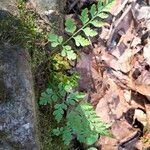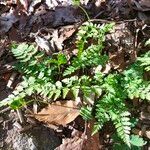Stems creeping, not cordlike, internodes long, 0.5--1 cm, with persistent petiole bases, covered with tan to golden hairs, especially toward apex; scales tan to light brown, ovate-lanceolate to lanceolate, radial walls thin, luminae tan, mostly crowded at stem apex. Leaves seasonally dimorphic, clustered 1 to several cm beyond persistent old petiole bases, especially in late spring and early summer, to 45 cm, bearing sori (earliest leaves smaller, sterile, coarsely divided, margins with rounded teeth; subsequent leaves larger, fertile, more finely divided, margins with sharply pointed teeth). Petiole mostly green to straw-colored throughout, shorter than or nearly equaling blade, base sparsely scaly. Blade ovate to elliptic, 1-pinnate-pinnatifid to 2-pinnate, widest at or just below middle, apex broadly acute; rachis and costae lacking gland-tipped hairs or bulblets; axils of pinnae lacking multicellular, gland-tipped hairs. Pinnae usually perpendicular to rachis, not curving toward blade apex, margins dentate to serrate; proximal pinnae pinnatifid to pinnate-pinnatifid, ± equilateral, basiscopic pinnules not enlarged, basal basiscopic pinnules stalked, base truncate to obtuse; distal pinnae deltate to ovate. Veins mostly directed into teeth. Indusia ovate to cup-shaped, lacking gland-tipped hairs. Spores spiny, usually 28--34 µm. 2 n = 84.
More
Rhizome long-creeping, sparsely scaly but densely villous, the growing point produced 2-4 cm beyond the often more scattered lvs; petiole greenish or stramineous except often at the very base; minor axes of the blade with scattered glands; veins typically running into marginal teeth; lowermost pinnules mostly cuneate at the base, and often short-petiolulate; indusium ca 0.5 mm, usually entire; 2n=84; otherwise much like no. 1 [Cystopteris fragilis (L.) Bernh.]. Abundant in mesic woods; N.Y. and s. Ont. to s. Minn., s. to Ga., Ala., La., and e. Kans. (C. fragilis var. p.)


